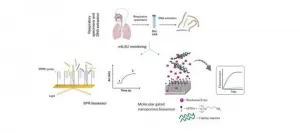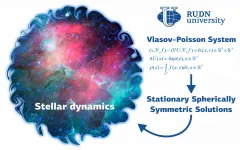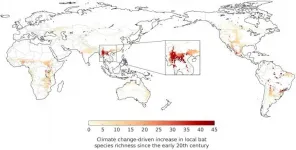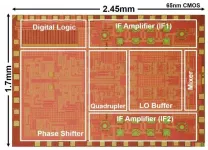(Press-News.org) We've all felt stressed at some point, whether in our personal or professional lives or in response to exceptional circumstances like the COVID-19 pandemic. But until now there has been no way to quantify stress levels in an objective manner.
That could soon change thanks to a small wearable sensor developed by engineers at EPFL's Nanoelectronic Devices Laboratory (Nanolab) and Xsensio. The device can be placed directly on a patient's skin and can continually measure the concentration of cortisol, the main stress biomarker, in the patient's sweat.
Cortisol: A double-edged sword
Cortisol is a steroid hormone made by our adrenal glands out of cholesterol. Its secretion is controlled by the adrenocorticotropic hormone (ACTH), which is produced by the pituitary gland. Cortisol carries out essential functions in our bodies, such as regulating metabolism, blood sugar levels and blood pressure; it also affects the immune system and cardiovascular functions.
When we're in a stressful situation, whether life-threatening or mundane, cortisol is the hormone that takes over. It instructs our bodies to direct the required energy to our brain, muscles and heart. "Cortisol can be secreted on impulse - you feel fine and suddenly something happens that puts you under stress, and your body starts producing more of the hormone," says Adrian Ionescu, head of Nanolab.
While cortisol helps our bodies respond to stressful situations, it's actually a double-edged sword. It's usually secreted throughout the day according to a circadian rhythm, peaking between 6am and 8am and then gradually decreasing into the afternoon and evening. "But in people who suffer from stress-related diseases, this circadian rhythm is completely thrown off," says Ionescu. "And if the body makes too much or not enough cortisol, that can seriously damage an individual's health, potentially leading to obesity, cardiovascular disease, depression or burnout."
Capturing the hormone to measure it
Blood tests can be used to take snapshot measurements of patients' cortisol levels. However, detectable amounts of cortisol can also be found in saliva, urine and sweat. Ionescu's team at Nanolab decided to focus on sweat as the detection fluid and developed a wearable smart patch with a miniaturized sensor.
The patch contains a transistor and an electrode made from graphene which, due to its unique proprieties, offers high sensitivity and very low detection limits. The graphene is functionalized through aptamers, which are short fragments of single-stranded DNA or RNA that can bind to specific compounds. The aptamer in the EPFL patch carries a negative charge; when it comes into contact with cortisol, it immediately captures the hormone, causing the strands to fold onto themselves and bringing the charge closer to the electrode surface. The device then detects the charge, and is consequently able to measure the cortisol concentration in the wearer's sweat.
So far, no other system has been developed for monitoring cortisol concentrations continuously throughout the circadian cycle. "That's the key advantage and innovative feature of our device. Because it can be worn, scientists can collect quantitative, objective data on certain stress-related diseases. And they can do so in a non-invasive, precise and instantaneous manner over the full range of cortisol concentrations in human sweat," says Ionescu.
Engineering improved healthcare
The engineers tested their device on Xsensio's proprietary Lab-on-SkinTM platform; the next step will be to place it in the hands of healthcare workers. Esmeralda Megally, CEO of Xsensio, says: "The joint R&D team at EPFL and Xsensio reached an important R&D milestone in the detection of the cortisol hormone. We look forward to testing this new sensor in a hospital setting and unlocking new insight into how our body works." The team has set up a bridge project with Prof. Nelly Pitteloud, chief of endocrinology, diabetes and metabolism at the Lausanne University Hospital (CHUV), for her staff to try out the continuous cortisol-monitoring system on human patients. These trials will involve healthy individuals as well as people suffering from Cushing's syndrome (when the body produces too much cortisol), Addison's disease (when the body doesn't produce enough) and stress-related obesity. The engineers believe their sensor can make a major contribution to the study of the physiological and pathological rhythms of cortisol secretion.
So what about psychological diseases caused by too much stress? "For now, they are assessed based only on patients' perceptions and states of mind, which are often subjective," says Ionescu. "So having a reliable, wearable system can help doctors objectively quantify whether a patient is suffering from depression or burnout, for example, and whether their treatment is effective. What's more, doctors would have that information in real time. That would mark a major step forward in the understanding of these diseases." And who knows, maybe one day this technology will be incorporated into smart bracelets. "The next phase will focus on product development to turn this exciting invention into a key part of our Lab-on-SkinTM sensing platform, and bring stress monitoring to next-generation wearables," says Megally.
INFORMATION:
The group led by Dr. Enrique J. Calderón - "Clinical Epidemiology and Vascular Risk" at the Institute of Biomedicine of Seville - IBiS/University Hospitals Virgen del Rocío and Macarena/CSIC/University of Seville, also a member of CIBERESP, participated in a project with researchers from CIBER-BBN, in which they developed systems to detect Pneumocystis jirovecii, an atypical fungus responsible for very severe pneumonia in immunosuppressed patients. The results have been published in the journals Nanomaterials and Journal of Fungi, and are the fruit of collaboration with the CIBER-BBN groups led by Dr. Laura Lechuga, ...
The spinal column consists of 24 vertebrae that provide axial support to the torso and protection to the spinal cord that runs through its central cavity. The vertebrae are connected by means of intervertebral discs. These discs are highly hydrated, flexible and highly mechanically resistant. They allow the column its flexibility and act as shock absorbers during daily activities such as walking, running and in impact situations, such as jumping.
These unique features are made possible by the discs' tissue composition and structure. At its centre, there is a gel-like ...
At the time of writing, coronavirus disease 2019 (COVID-19) is seriously threatening human lives and health throughout the world. Before effective vaccines and specific drugs are developed, non-pharmacological interventions and numerical model predictions are essential. To this end, a group led by Professor Jianping Huang from Lanzhou University, China, developed the Global Prediction System of the COVID-19 Pandemic (GPCP).
Jianping Huang is a Professor in the College of Atmospheric Sciences and a Director of the Collaborative Innovation Center for Western Ecological Safety, Lanzhou University, China. He has for a long time been dedicated to studying ...
The Vlasov-Poisson equations describe many important physical phenomena such as the distribution of gravitating particles in the interstellar space, high-temperature plasma kinetics, and the Landau damping effect. A joint team of scientists from the Mathematical Institute of RUDN University and the Mathematical Institute of the University of Munich suggested a new method to obtain stationary solutions for a system of Vlasov-Poisson equations in a three-dimensional case. The obtained solutions describe the phenomena of stellar dynamics. The results of the study were published in the ...
Global greenhouse gas emissions over the last century have made southern China a hotspot for bat-borne coronaviruses, by driving growth of forest habitat favoured by bats.
A new study published today in the journal Science of the Total Environment provides the first evidence of a mechanism by which climate change could have played a direct role in the emergence of SARS-CoV-2, the virus that caused the COVID-19 pandemic.
The study has revealed large-scale changes in the type of vegetation in the southern Chinese Yunnan province, and adjacent regions in Myanmar and Laos, over the last century. Climatic changes ...
Neanderthals' gut microbiota already included some beneficial micro-organisms that are also found in our own intestine. An international research group led by the University of Bologna achieved this result by extracting and analysing ancient DNA from 50,000-year-old faecal sediments sampled at the archaeological site of El Salt, near Alicante (Spain).
Published in Communication Biology, their paper puts forward the hypothesis of the existence of ancestral components of human microbiota that have been living in the human gastrointestinal tract since before the separation between the Homo Sapiens and Neanderthals that occurred more than 700,000 years ago.
"These results allow us to understand which components of the human gut microbiota ...
New research has identified a nanostructure that improves the anode in lithium-ion batteries
Instead of using graphite for the anode, the researchers turned to silicon: a material that stores more charge but is susceptible to fracturing
The team made the silicon anode by depositing silicon atoms on top of metallic nanoparticles
The resulting nanostructure formed arches, increasing the strength and structural integrity of the anode
Electrochemical tests showed the lithium-ion batteries with the improved silicon anodes had a higher charge capacity and longer lifespan
New research conducted by the Okinawa Institute of Science and Technology ...
USC researchers have developed a new method to counter emergent mutations of the coronavirus and hasten vaccine development to stop the pathogen responsible for killing thousands of people and ruining the economy.
Using artificial intelligence (AI), the research team at the USC Viterbi School of Engineering developed a method to speed the analysis of vaccines and zero in on the best potential preventive medical therapy.
The method is easily adaptable to analyze potential mutations of the virus, ensuring the best possible vaccines are quickly identified -- solutions that give ...
The early prognosis of high-risk older adults for amnestic mild cognitive impairment (aMCI), using noninvasive and sensitive neuromarkers, is key for early prevention of Alzheimer's disease. A recent study, published in the Journal of Alzheimer's Disease, by researchers at the University of Kentucky establishes what they believe is a new way to predict the risk years before a clinical diagnosis. Their work shows that direct measures of brain signatures during mental activity are more sensitive and accurate predictors of memory decline than current standard behavioral testing.
"Many studies have measured electrophysiological rhythms during resting and sleep ...
Scientists at Tokyo Institute of Technology (Tokyo Tech) and NTT Corporation (NTT) develop a novel CMOS-based transceiver for wireless communications at the 300 GHz band, enabling future beyond-5G applications. Their design addresses the challenges of operating CMOS technology at its practical limit and represents the first wideband CMOS phased-array system to operate at such elevated frequencies.
Communication at higher frequencies is a perpetually sought-after goal in electronics because of the greater data rates that would be possible and to take advantage of underutilized ...





